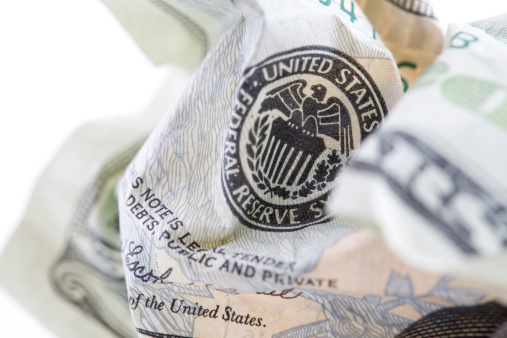U.S. Highlights
- February’s Consumer Price Index report showed that inflation came in higher-than-expected for a second consecutive month – a development which is likely to be on the Fed’s agenda at their two-day meeting next week.
- Spending in the retail sector disappointed expectations, despite some recovery from last month’s notable decline.
- With inflation top of mind, U.S. small businesses were also feeling less optimistic in February.
Canadian Highlights
- Canadian bond yields climbed this week, reflecting developments south of the border and domestic inflationary concerns.
- Canadian households saw a sizeable increase in net worth in the fourth quarter of 2023, fueled by financial market gains and restrained liability growth. Anticipated wealth gains in Q1 may prove to be a tailwind for consumer spending.
- Quebec’s budget highlighted fiscal challenges with rising debt levels, while the upcoming federal update in April is likely to see upward revisions to government revenues but offers limited fiscal leeway.
U.S. – Sticky Prices Could Delay Rate Cuts
The key data among this week’s releases was the consumer price inflation numbers. While the headline monthly figure was in line with expectations, the details could give the Fed more to discuss in their upcoming policy meeting next week. Markets took the report in stride, with Treasury yields up a bit and the major stock indices closing the day higher after the release.
Delving into the details, the CPI report showed that both monthly and annual headline inflation accelerated in February, largely reflecting a rise in gasoline and shelter prices. This was also accompanied by higher-than-expected figures for both monthly and annual core inflation. Notably, the prices for core goods unexpectedly ticked higher in February after eight consecutive months of price declines. Back-to-back months of stronger than expected readings on core inflation point to an uneven road ahead as the Fed attempts to steer inflation back to target.
Price pressures further up the supply chain were also a little hotter than expected in February. The Producer Price Index (PPI) also came in above expectations. Both the monthly and annual headline PPI numbers accelerated relative to January. As such, both the consumer and producer price reports suggest that inflationary pressures remain sticky (Chart 1).
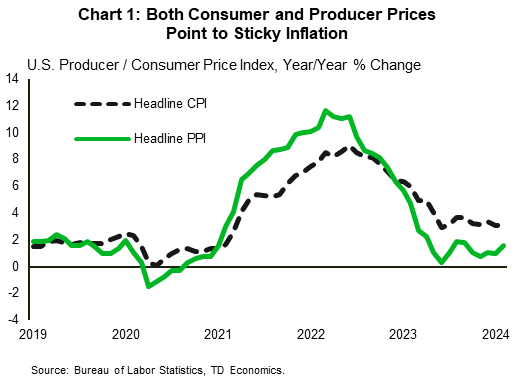
Adding to the subjects that the Fed will likely be mulling over during their meeting, is the 0.6% m/m gain in February’s retail sales after a sizeable pullback in January. On the upside, while retail sales growth flipped back to positive territory, it was lower than market expectations (0.8%). What’s more, the control group category, which factors into the calculation of personal consumption expenditure, was flat on the month relative to expectations for growth. Overall, the data suggests that consumers still have the ability to spend, despite challenges to their balance sheet, such as higher prices.
Inflation was also high on the list of concerns for America’s small businesses. A net 23% of respondents to the NFIB’s small business survey noted that inflation was their single most important business problem, up three points from the previous reading (Chart 2). Overall, small businesses were less optimistic in February, with the optimism index dropping to a nine-month low of 89.4. This was lower than market expectations for a slight improvement and notably below the series’ 50-year average of 98. On the upside, small businesses are having an easier time attracting and retaining employees, such that the net percentage of firms who increased compensation or are planning to do so in the near-term both fell over the month.
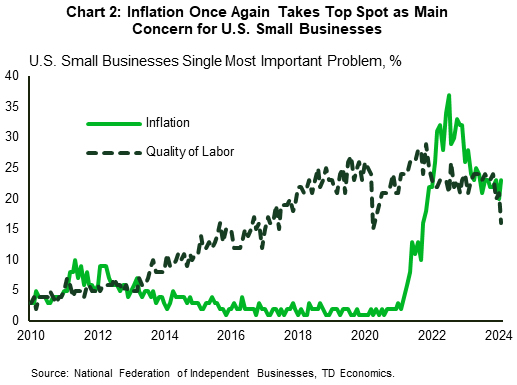
The key takeaway from this week’s releases is that while the labor market is normalizing as indicated by responses from the small business sector, consumers still have spending power and inflationary pressures have not fully abated. The combination suggests that the Fed is likely to remain cautious with respect to rate cuts, erring on the side of leaving rates higher for longer rather than take the risk of re-igniting price pressures by cutting prematurely.
Canada – Wealth Boost May Cheer Some Consumers
This week saw a quieter pace in economic data, leaving financial market sentiment largely influenced by developments south of the border. There, expectations for higher rates firmed in light of more persistent inflationary pressures and sustained consumer activity, nudging the Canadian government’s 5-year rate benchmark up by more than 20 basis points. Initially buoyed by the International Energy Agency’s revised oil demand growth estimates for 2024, the S&P TSX index reached its highest level since April 2022 but retreated later, closing 0.6% higher for the week.
Sparse though it was, the week brought forward several second-tier data releases. The national balance sheet and financial flow accounts for Q4 2023 showed that Canadian household net worth grew by $290 billion, offsetting the previous quarter’s decline. This uptick nudged wealth growth back into positive territory for Q4, edging the year-end balance closer to its 2021 zenith. Gains in the financial markets and subdued liabilities growth delivered a boost to Canadian households’ wealth.
The apparent rebound in household wealth towards 2023’s end could be behind a renewed consumer momentum in recent months. The concept of “the wealth effect”, though theoretical in classical economics, tangibly influences sentiment. This means an upgrade in consumer spending might be in the books. So far in the first quarter equity prices remain on an upswing. In addition, we expect home prices to turn positive this quarter, supporting wealth gains. Today’s report on housing starts suggests that February’s sizeable increase in starts was at least partially driven by a rebound in housing market activity and rising home prices. Furthermore, our internal spending data shows a fourth consecutive month of spending increases in February (Chart 1). This suggests Q1 may prove relatively buoyant for consumer spending.
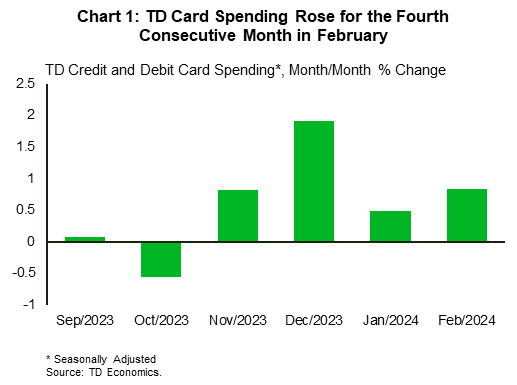
The potential wealth effect on consumer spending, however, likely remains confined to a fraction of Canadian families. Adjusted for inflation and population growth, households’ wealth is back to late 2020 levels and is only around 7% higher than the 2019 level (Chart 2). Compare this to the peak in Q4 2021, when this measure was 26% higher. Since then, real spending per capita contracted in five out eight last quarters. As more Canadians renew their mortgages at higher rates, the economy braces for a period of below-trend growth amid rising debt servicing costs.
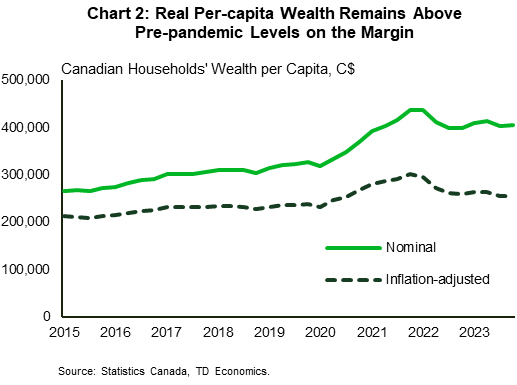
Weak revenue growth and debt servicing costs were top of mind for Quebec’s fiscal authorities as they prepared the province’s budget. Expectations for the fiscal outlook have dimmed, with an anticipated rise in the debt-to-GDP ratio to 40% by FY2025/26 due to increased spending and tepid revenue growth. The Government of Canada is also preparing for its April 16th Budget, where we expect upward revisions to nominal GDP forecasts to boost government revenues, but offer limited fiscal leeway. Major new expenditures are unlikely, with nationwide pharmacare likely being the most heavily discussed item. After all, the government seems to be attuned to the need of striking the right balance between cost and effectiveness, while ‘creating the conditions’ for interest rates to fall.

